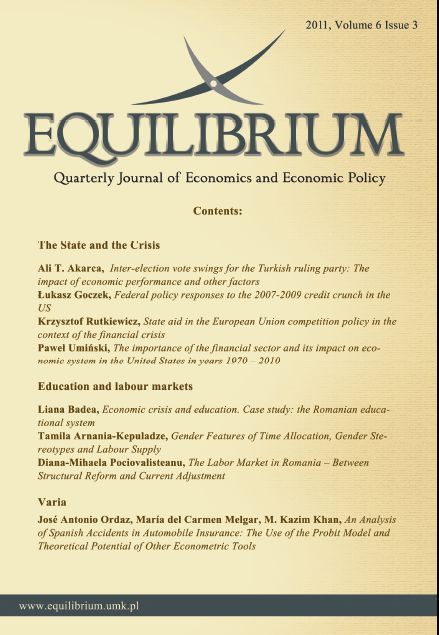Gender Features of Time Allocation, Gender Stereotypes and Labour Supply
DOI:
https://doi.org/10.12775/EQUIL2011.022Keywords:
gender, time allocation, labor supplyAbstract
Securing the well-being, protection of human rights and equality on the ground of age, gender, race, nationality etc along with sustainable economic development becomes the most important goal for any country. Gender differences in labor market are a problem of many countries. Being a larger demographic group, women have played a vital role in employment and economic development. Despite longstanding striving for gender equality, the inequality manifests itself in labor markets around the world. There is no common opinion on the reasons of the existence of gender differences in economic literature. After decades of research most investigators would agree that there can be no single-factor explanation for gender inequality in the labor market. One of the conventional explanations of gender gap in employment sphere includes the differences in men?s and women?s preferences in working hours due their stereotypical roles in the private and public life. This paper is focused on the study of gender feature of time allocation and its impact on the labor supply by men and women. For this purpose, based on the different types of activity, particular: income getting or income increasing promote activity, non-monetary income obtain activity, income-make activity, non-income-make activity, indirect-receipts activity, the author introduces the time allocation model which includes parameters such as working time, leisure, non-working time, using time, free time and time for satisfying an individual?s physiological needs. For the attribution of different types of practice to certain kinds of activity the ?principle of dominant purpose of activity? was offered. According to given time allocation model, the pattern of features of labor supply by men and women is offered in the paper.
Downloads
References
Arnania-Kepuladze T. (2008), Working Women in Georgia: a Sight from Within. International Conference ?Think Together?. Prague.
?Arnania-Kepuladze T. (2010), The Time Allocation and Time Division: Theoretical Approach, International Scientific-Practical Conference?Actual Economic Problems at Current Stage of Global Development?, Publishing House of Paata Gugushvili Institute of Economics, ISBN: 978?9941?9060?7?7. Tbilisi, 2010.
Becker P. E., Moen P. (1999), Scaling Back: Dual-Earner Couples? Work- Family Strategies. ?Journal of Marriage and the Family?, 61: 995-1007.
Equality at Work: Talking the Challenges; Comprehensive proposal for the composite entity for gender equality and the empowerment of women (A/64/588), 2010, New York.
Comprehensive proposal for the composite entity for gender equality and the empowerment of women (A/64/588), 2010, New York
Convention on the Elimination of All Forms of Discrimination against Women (CEDAW). 1979.
Segal E. S. (2004), Cultural Constructions of Gender, [in] Ember Carol R and Melvin Ember (ed.), Encyclopedia of sex and gender: men and women in the world?s cultures, ISBN 0-306-47770-X.
Equality at Work: Talking the Challenges. Global Report under the follow-up to the ILO Declaration on Fundamental Principles and Rights at Work, 2007, International Labour Conference, 96th Session, ILO, Geneva 2007, ISBN 978-92-2-118130-9, ISSN 0074-6681.
Erickson R.J., Gecas V. (1991), Social class and fatherhood, [in] Bozett F.W., Hanson S.M.H.(ed), Fatherhood and Families in Cultural Context, 114-37. New York: Springer-Verlage.
Frank R. H. (2006), Microeconomics and behavior. New York: McGraw-Hill.
Glick P. (1991), Trait-based and sex-based discrimination in occupational prestige, occupational salary, and hiring. Sex Roles, v.25, p. 351-378.
Happiness Across the Life Cycle: Exploring Age-Specific Preferences. By Orsolya Lelkes. Europoan Centre for Social Welfare Policy and Research. http://www.euro.centre.org/lelkes (accessed April 12, 2009).
Hakim, C. (2002), Work-Lifestyle Choices in the 21st Century ? Preference Theory. New York: Oxford University Press. http://books.google.cz/books?id=XmHYRDqRnYYC&dq =Hakim+C.+Work-lifestyle+choices&printsec=frontcover&source=bn&hl=cs&ei=Vgy-Ss6BFcP0_Ab_qfBt&sa=X&oi=book_result&ct=result&resnum=4#v=onepage&q=Hakim%20C.%20Work-lifestyle%20choices&f=false (accessed September 26, 2009).
Hakim, C. (2006), Women, careers, and work-life preferences, British Journal of Guidance & Counselling, Vol. 34, No. 3,pp. 279- 295.
Howard H.V., Bianchi S. M. (1994), Married Mothers? Work Patterns: The Job-Family Compromise. Monthly Labor Review (June): 24-30.
Hochschild A. (1989),The Second Shift. New York: Viking Press.
Hodgson G. M. (2007), Evolutionary and Institutional Economics as the New Mainstream?, Evol. Inst. Econ. Rev. 4(1): 7?25.
Hofstede G. (2001), Culture's Consequences: Comparing Values, Behaviors, Institutions, and Organizations Across Nations. 2-nd edn. Thousand Oaks, CA: Sage Publications.
Household budgets and time use. http://www.destatis.de/jetspeed/portal/cms/Sites (accessed Octomber 16, 2008).
Hugh G., Ress. R. (2004), Microeconomics. Harlow: Pearson Education Limited.
Jacobsen J. P. The economics of gender. Second Edition. Blackwell Publishing. http://books.google.cz/books?id=DYWd8TACgpEC&dq=gender+economics&printsec=frontcover&source=bl&ots=jN__7iq9NQ&sig=pW4y6fJA-QYbOvfOAMoE6vCv2t0&hl=cs&ei= krjgSczDE9qKsAbW2q3RCA&sa=X&oi=book_result&ct=result&resnum=4#PPR7,M1 (accessed May 5, 2009).
Machina ?M.J. (1987), Choice Under Uncertainty: Problems Solved and Unsolved. The Journal of Economic Perspectives, Vol. 1(1): 121-54.
Moen P., Harris-Abbott D., Lee S., Roehling P. (1999), The Cornell Couples and Careers Study. Cornell Employment and Family Careers Institute. http://www.dol.gov/oasam/programs/history/herman/reports/futurework/conference/cornell.pdf (accessed September 21, 2009).
Moen P., Sweet S. (2002), The New Workforce, the New Economy, and the Lock-Step Life Course: An American Dilemma. Brofenbrenner Life Course CenterWorking Paper N02-21.
Perry-Jenkings M., Serry B. Crouter A.C. (1992), Linkages between woman?s provider ? role attitudes, psychological well-being and family relationships. Psychology of Women Quarterly. V.16, p.311-29.
Pleck J. H. (1985), Working Wives / Working Husbands. Beverly Hills; Sage,
Pindyck R. S., Rubinfeld D. L. (2005), Microeconomics. USA: Pearson Education International.
Stephen, Hope. (1999), Applied microeconomics. Chichester: John Wiley&Sons Ltd.
Tanenbaum L. (2002), Catfight: Women and competition. New York: Seven Stories Press. http://www.google.com/books?hl=cs&lr=&id=9BPffn0 MpJEC&oi=fnd&pg=PA13&dq=Tanenbaum,+L.+(2002).+Catfight:+ Women+and+competition.+ NY:+Seven+Stories+Press.&ots= 3uUwLXTQ Rm&sig= Jfw-6yREmtYz9yIbVt1TZ5jcjA#v=onepage&q=&f= false (accessed September 21, 2009).
Tversky As. (1991), Rational theory and Constructive choice: a Reference Dependant Model. Quarterly Journal of Economics, V.107(4): 1039-61.
Wirth L. (2004), Breaking through the glass ceiling. Women in management. www.cinerfor.org.uy/public/english/region/ampro.
Women and men in Georgia (2008), Tbilisi: Department of Statistics.
???????-??? ?.?. (2006) ????????? ???????. ?????????? ????????????? ?????????. ??????: ?????.






